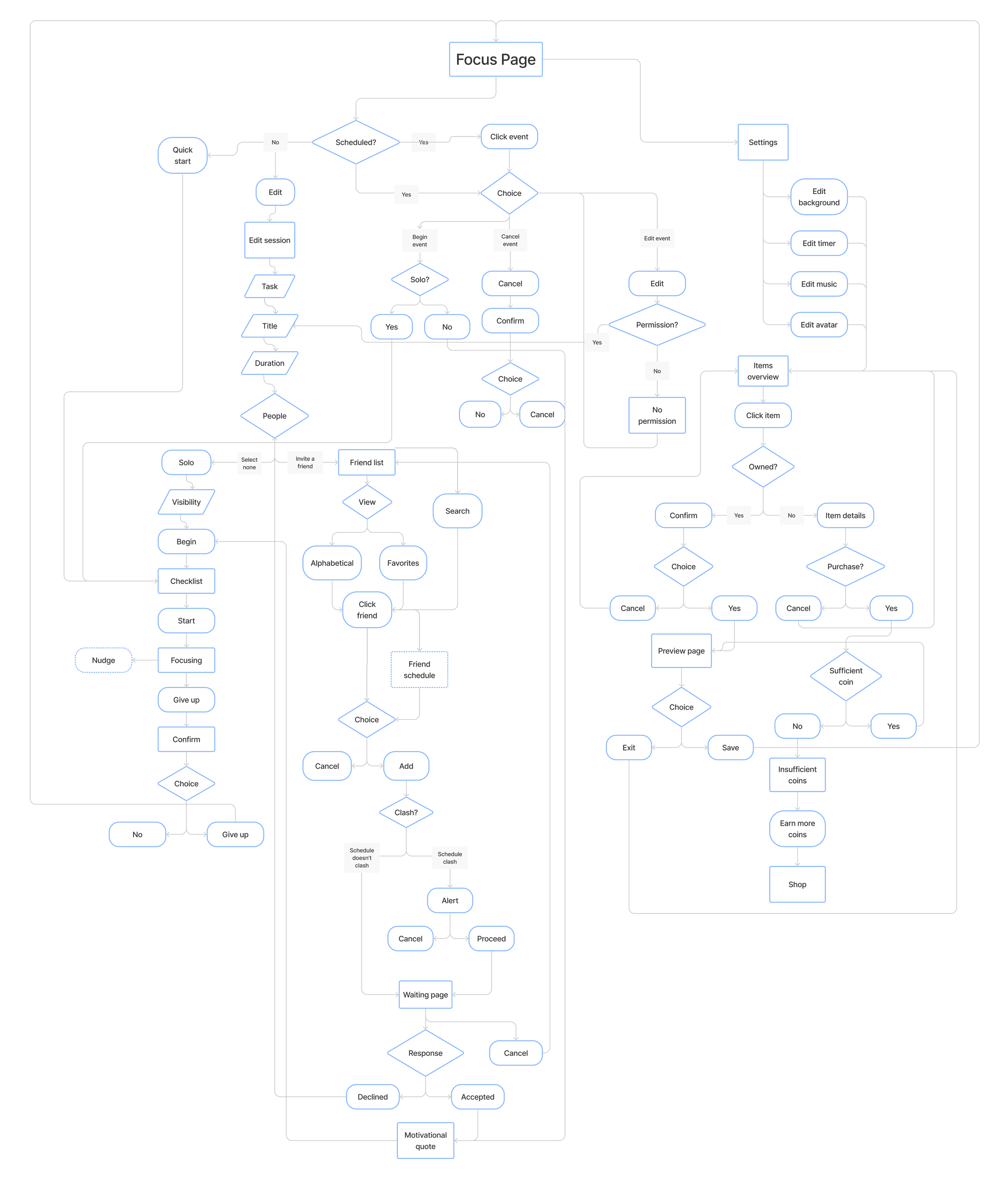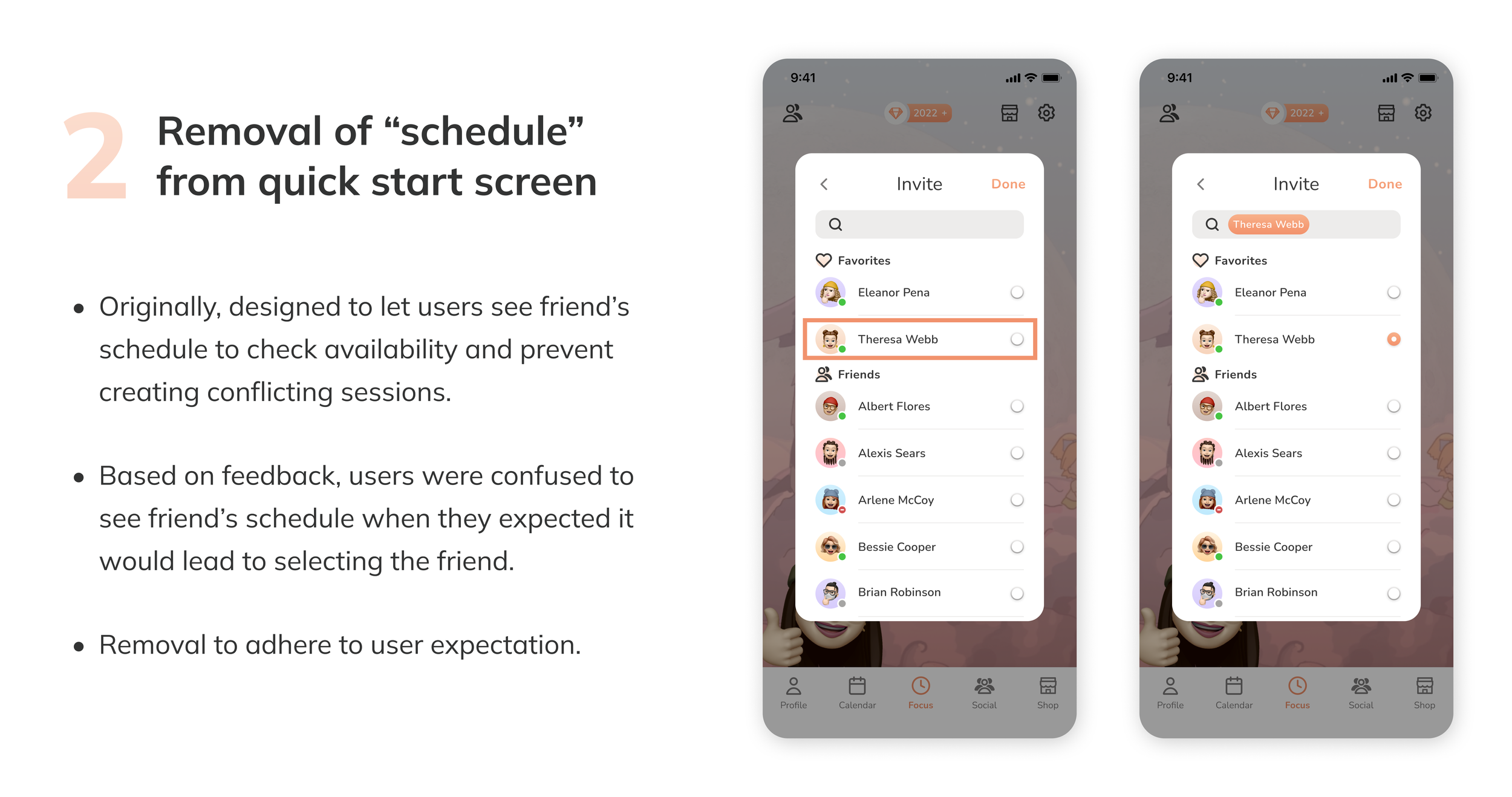Productivity app designed to improve focus and motivation for remote work.
Folkus

Problem
The global pandemic has changed the way people live and work permanently.
With remote and hybrid work models becoming the new norms, people want to stay productive and motivated but often find themselves feeling isolated and losing focus at home, affecting their performance.
Challenge
Working or studying in a distraction-free setting like an office or library boosts concentration, especially with peers nearby to keep each other accountable. With the WFH model, individuals need a better solution to make remote working more productive.
Goal
Create a solution to improve individuals’ focus and motivation by tackling the psychological challenges they face during remote working and learning.
Overview
Scope
Self-started project
My Role
Involved in end-to-end user process from Secondary Research, User Interview, Usability Testing, Wireframe, Prototype
Timeline
Oct 2021 - Apr 2022
Team
Sole UX/UI Designer
Solution
Key Moments & Use Cases
Focus efficiently without getting distracted.
Use Pomodoro timer to help you manage time and focus in intervals uninterruptedly
Set up pre-focus ritual as cues to concentrate which can foster automaticity that allows you to focus on tasks at hand
Invite friends or group as your accountability partners to motivate and support each other
Earn reward coins by completing study sessions to build your ideal study ambience with different avatar, background, music or timer
Keep track of tasks and deadlines.
Break down big projects by dividing tasks into multiple focus sessions*
Track and manage all tasks at glance
Measurable progress with ‘tag’ and ‘priority’ sorting
*Research suggests people are more likely to accomplish their goals when they are broken into specific, measurable, attainable, realistic, time-bound tasks.
Stay connected with peers to feel more motivated and less lonely & isolated.
Invite friend or peer to do focus session on spot
Schedule session ahead to do focus sessions in pair or group
Interact with friends and peers on ‘timeline’
View friends’ and peers’ activities and schedule
Research
Secondary Research
Remote working and learning have become the new norms and changed the way people live and work permanently. From my research, they are not only the new norms but also are likely to stay even after the pandemic.
Research suggests that the switch to online learning damaged students' focus and motivation — a loss that may be counteracted by living on or near campus. Students of all ages have performed worse academically since the transition to remote learning (EAB, 2020).
Increased feelings of loneliness/isolation, decreased sense of belonging to the workplace and lack of social support have become more prevalent and affected individuals' focus and performance.
Competitive Analysis
Google Trends: search volume of “study with me” query 3x over the past 5 years.
In “study with me” (SWM) videos, you can expect to see someone studying, often incorporating Pomodoros and calming music in the background.
Source: Abao in Tokyo (Youtube)
YouTube: video views with titles that contain “study with me” increased by 54% in 2020 from 2019 in the U.S.
Some SWM live streamers are viewed by 1,000+ viewers at a time.
There are also SWM creators who have 800,000+ YouTube subscribers.
So, what does this mean?
There is an increasing demand for this type of content. Why?
Source: “Personalizing Ambience and Illusionary Presence: How People Use ‘Study with me’ Videos to Create Effective Studying Environments” (2021)
Survey Results
First, I surveyed 42 people who are working or studying remotely.
79%
are always working or studying remotely
79%
have more than 3 months of remote experience
95%
are not completely satisfied with remote experience
User Interviews
After gathering research and having a more solid understanding of the overall remote working and studying experiences, I conducted user interviews to dive deeper into identifying people's needs and pain points while working or studying remotely.
Examine the indirect internal challenges remote workers and students faced that affected focus and motivation
Goal
7 interviews (45 min, 1-on-1)
3 remote workers & 4 remote students (1 had remote work experience)
Participants
Setting & Schedule
Remote Experience
Productive moments & Motivation
Unproductive moments & Distraction
Support System
Interview Topics
Insights
Affinity Map
Legend for the stickies: Purple = Insights, Blue = Quotes, Yellow = Summaries
User quotes that highlighted the difficulties encountered in their remote experience
Main Learnings
After gathering and organizing the notes from my user interviews into an affinity map, I've realized that many people coming from different background share similar thoughts and feelings.
Congruent with my secondary research findings, even though most people enjoy the flexibility remote working/studying provides, many report feeling drained, difficulties in shutting off work and managing time.
I’ve noticed that the recurring themes that lead to inefficiency are certainty, support, and setting. The degree of certainty, support and setting impact users’ productivity.
Ideation
How might we…
increase productivity, efficiency, and reduce distractions for remote workers or students?
fulfil the need for human interactions and emotional support for remote workers or students?
increase motivation or implement a reward system in people’s daily routines?
Solution Ideation
Figure 1
Figure 2
Figure 3
Figure 1 and 2 are ideation concepts. When I was brainstorming the ideas for this project, I explored different concepts that could help solve the problem, such as turning on the camera to study with peers. Even having the navigation pages as different virtual “rooms”, so for example, the “office” will be where users focus and the “living room” will be a common area for users to relax and chat with friends.
However, all of these concepts defeat the main purpose of the app, instead, it can end up distracting the users more. Having all these additional features will be too crowded and shifts the focus away from being a productivity app, which definitely counterintuitive to its name, “Folkus”.
After organizing and identifying the context for the app, I broke down the navigation into 5 main pages: profile, calendar, focus, social, and shop (shown in Figure 3).
User Flows
To align with the users’ needs and goal of the app, I narrowed down the focus to 3 main user flows most important for the users to complete: focus, calendar, and social (shown in the slideshow below).
Sketches & Wireframes
After gaining a better understanding of how users will navigate the app through the core user flows, I brought these ideas to life with sketches and wireframes shown below.
Figure 1: Focus Flow
Figure 2: Calendar Flow
Figure 3: Social Flow

Design
Testing
Key Learnings
In order to evaluate my designs, I conducted multiple rounds of testing. The scenarios prompted are based on the 3 main user flows crucial to achieving the use cases.
Guerilla testing with 5 users
2 rounds of moderated usability testing with 5 users each
Result: Reduced task completion error rate by 62%
Here are the major improvements that I’ve made based on the various feedback that I’ve received.
However, this doesn’t resolve my original concern...
What happens when user creates conflicting sessions?
Final Prototype
Reflection
Takeaways
Prioritizing MVP is very crucial
As mentioned in the brainstorming part, I have spent a great deal of time exploring different options. While generating ideas is very crucial, it is also important to think intentionally to prevent unnecessary functions and features that will not contribute to the main objectives.
When developing user flows for my app, I extensively evaluated all areas of the user’s route to very detailed considerations like which condition allows the user to change the visibility of a session and what the system will show when the user tries to purchase something with insufficient coins. Half of the user flows were not designed in the end. I realized that sometimes overthinking leads to losing sight of what should be prioritized and what can help solve the main problem.
Document the process
Throughout the whole project, I have taken careful documentation of every process, design decision and change. It not only makes it easier to write my case study later on but also was very helpful to reference my past notes when I had to brainstorm anything to make sure that I adhere to the project goal.
Next Steps
Add onboarding screens
Since many people have not used or heard of “Pomodoro” before, the “focus” screen can be a bit confusing to users at first. Thus, adding an onboarding experience when users get started can be helpful for them to navigate through the different features and concepts. However, I also know it is not necessary as of now because it is not the prime focus of the app and some users skip through the onboarding so I shouldn’t rely on it as the solution.
Dive deeper into gamification concepts
I would love to explore gamification psychology more to design the “shop” page in Folkus. By delving deeper into gamification, I can create a more comprehensive and engaging reward and punishment system that will help users better achieve their goals, and increase user engagement and retention. Potentially, this would be a crucial part of the business model if the app were to go live.





























